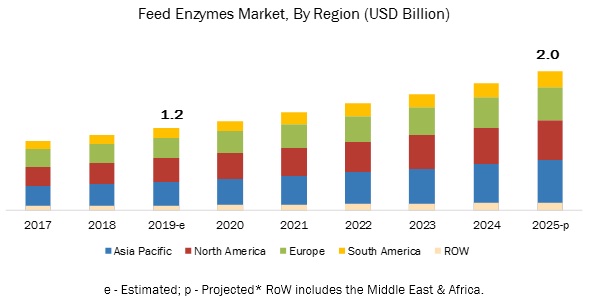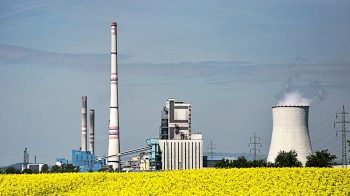The report “Feed Enzymes Market by Type (Phytase, Carbohydrase, and Protease), Livestock (Poultry, Swine, Ruminants, and Aquatic Animals), Source (Microorganism, Plant, and Animal), Form (Dry and Liquid), and Region – Global Forecast to 2025″ The global feed enzymes market size is projected to reach USD 2.0 billion by 2025, which was estimated at USD 1.2 billion in 2019; it is projected to grow at a CAGR of 9.1% from 2019. One of the major factors driving the feed enzyme industry is the provision of cost-efficiency in the use of feed. Also, the increasing demand for animal-based products, such as meat products, dairy products, and eggs, and the rise in the global demand for naturally produced feed additives have been driving the growth of this market.

Report Objectives:
- To describe and forecast the feed enzymes market, in terms of type, livestock, source, form, and region
- To describe and forecast the feed enzymes market, in terms of value and volume, by region–Asia Pacific, Europe, North America, South America, and the Rest of the World-along with their respective countries
- To provide detailed information regarding the major factors influencing market growth (drivers, restraints, opportunities, and challenges)
- To strategically analyze micromarkets with respect to individual growth trends, prospects, and contributions to the overall market
- To study the complete value chain of feed enzymes
- To analyze opportunities in the market for stakeholders by identifying the high-growth segments of the feed enzymes market
Download PDF Brochure:
https://www.marketsandmarkets.com/pdfdownloadNew.asp?id=1157
The phytase segment, by type, is projected to dominate the feed enzymes market during the forecast period.
Phytases are digestive enzymes that release plant phosphorus from phytic acid; monogastric animals, such as poultry birds, lack sufficient phytases to release this phosphorus. Adding extra phytases to the diet increases phytate breakdown and consequent utilization of plant phosphorus. According to DuPont, one of the major feed enzyme manufacturers, phytases are the most widely used type of feed enzymes in the world, included in 90% of poultry and 70% of swine diets. This segment accounted for the highest share of almost 48.0% in 2019 at a global level. Thus, increasing phytic acid degradation and the need to improve the availability of plant phosphorus could offer major benefits for poultry and swine producers, including lower levels of inorganic phosphorus inclusion in diets, reduced feed costs, and better sustainability of animal production.
The poultry segment, by livestock, is projected to witness the highest growth in the feed enzymes market during the forecast period, due to the increased consumption of poultry meat in the Asia Pacific region.
The poultry segment is projected to grow at the highest rate during the forecast period since there is intensive usage of feed enzymes in the broiler feed, which influences high tender meat production. Poultry does not produce enzymes for hydrolysis of non-starch polysaccharide present in the cell wall of grains, and they remain un-hydrolyzed. This results in low feed efficiency. Feed enzymes break down the NSPs, decrease intestinal viscosity, and eventually improve the digestibility of nutrients by improving gut performance. Poultry in the Asia Pacific region is also witnessing an ever-increasing demand, as consumers are adding white meat instead of red meat to their diets. Additionally, poultry population growth, which has doubled in the last two decades, according to the Food and Agriculture Organization of the United Nations (FAO), is supporting the high growth rate of the poultry segment.
Speak to Analyst:
https://www.marketsandmarkets.com/speaktoanalystNew.asp?id=1157
Asia Pacific is projected to account for the largest feed enzymes market share during the forecast period.
Asia Pacific dominated the feed enzymes market in 2018; this has been supported by the presence of a large livestock population (FAO 2016) and the growth rate. Also, livestock producers in China and India are focusing on animal health by resorting to natural solutions.
Additionally, there has been a rise in the demand for meat and meat products, in accordance with the need for a protein-rich meat diet. The market for poultry is estimated to increase in India and China due to factors such as the focus on meat quality and public health campaigns, which encourage the consumption of lower-fat protein options. Fish consumption is also increasing in the region owing to similar health trends. On the other hand, there has been an increase in production as well as consumption of dairy products in the region. These factors are expected to drive the feed enzymes market in the Asia Pacific region.
The major vendors in the global feed enzyme market are BASF SE (Germany), DowDu Pont (US), Koninklijke DSM N.V (Netherlands), Bluestar Adisseo (China), and Kemin Industries (US).
